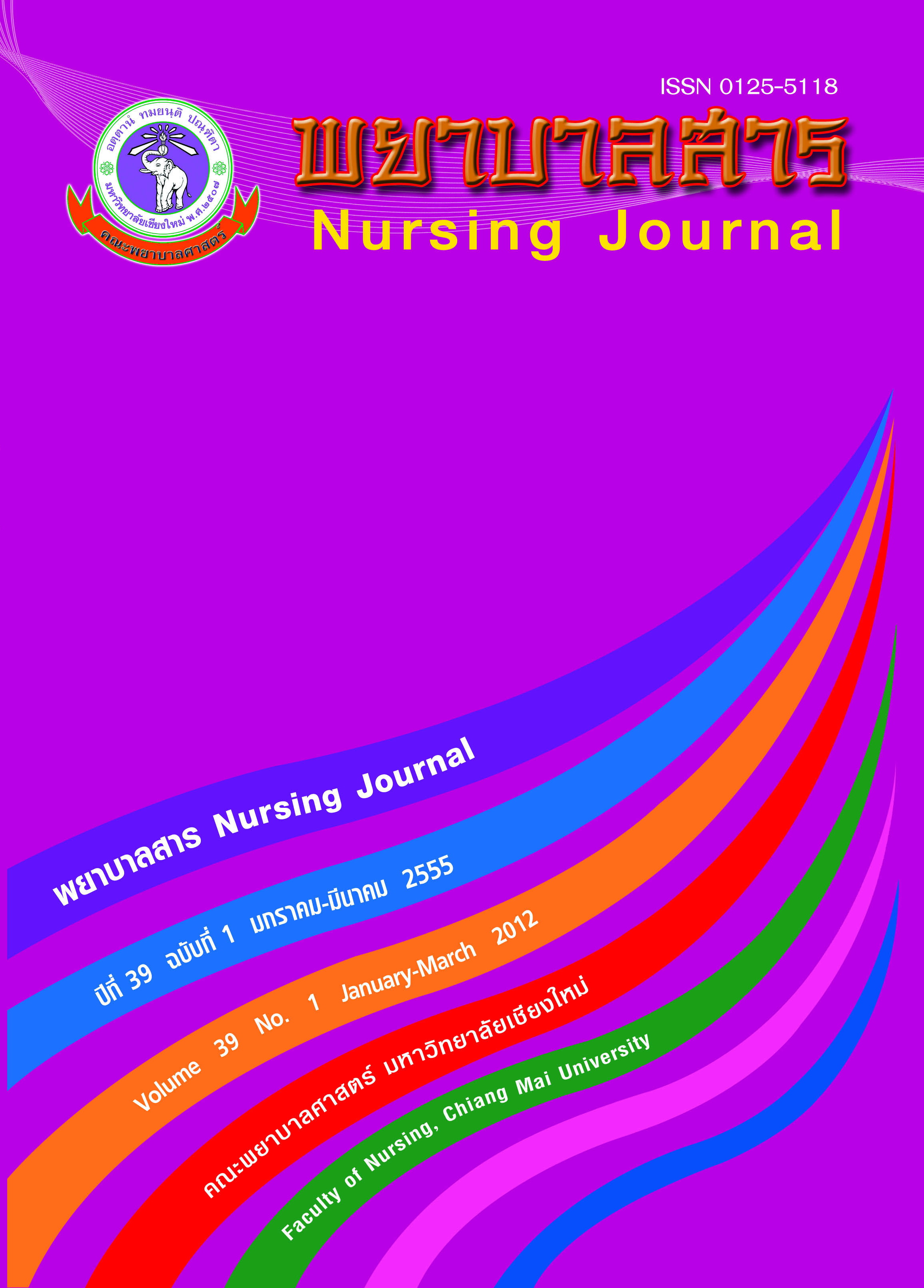การพัฒนาระบบสุขภาพชุมชน โดยชุมชน เพื่อชุมชน: กรณีศึกษาชุมชนตำบลไชยสถาน
Keywords:
ระบบสุขภาพตำบล, ระบบสุขภาพชุมชน, ชุมชนเข้มแข็ง, Sub-district Health System, Community Health System, Strengthen CommunityAbstract
บทคัดย่อ
การพัฒนาระบบสุขภาพตำบลให้ประสบความสำเร็จเกิดจากการมีส่วนร่วมและการเป็นหุ้นส่วน ของมวลสมาชิกและองค์กรกลุ่มต่าง ๆ ที่อยู่ในชุมชน ที่มีเป้าหมายร่วมกันในการพึ่งตนเองด้านการดูแล สุขภาพของชุมชนการวิจัยครั้งนี้เป็นการวิจัยถอดบทเรียนและการวิจัยตามกระบวนการมีส่วนร่วมในพื้นที่ เพื่อศึกษาและถอดบทเรียนกระบวนการการพัฒนาระบบสุขภาพตำบล และศักยภาพของตำบลไชยสถาน แบบมีส่วนร่วมของประชาชน องค์กรบริหารส่วนท้องถิ่นสถานบริการสุขภาพ และสถาบันการศึกษา โดย ใช้กระบวนการรวบรวมข้อมูลจากข้อมูลหลัก 4 ชุด ได้แก่ 1) ข้อมูล 7 ส่วนที่แสดงโครงสร้างหลักของตำบล 2) ชุดข้อมูลวิเคราะห์ปัญหาและสาเหตุที่มาของปัญหา 3) ชุดการจัดการที่แสดงให้เห็นกระบวนการเสริม สร้างชุมชนให้เข้มแข็ง และ 4) ชุดข้อมูลผลลัพธ์ที่แสดงถึงสถานะความเข้มแข็งของตำบล (ขนิษฐา นันทบุตร และคณะ, 2553) จากนั้นนำข้อมูลที่ได้จากการสังเคราะห์ไปสะท้อนให้ชุมชนรับรู้และชุมชนได้เกิดการ ตระหนักถึงปัญหาสุขภาพของชุมชนร่วมกัน และจัดตั้งคณะทำงานร่วมกันทุก ภาคส่วนในการแก้ไขปัญหา สุขภาพที่ชุมชนให้ความสำคัญเป็นอันดับแรก
ผลการวิจัยพบว่า
1. โครงสร้างหลักตำบล ได้แก่ ทุนทางสังคม ประกอบด้วย บุคคลสำคัญ บุคคลแกนนำ ผู้นำ คนเก่ง อาสาสมัคร มีระบบการสื่อสารได้แก่ การเข้าถึงข้อมูลของชุมชน ปัญหาสุขภาพได้แก่ การดูแลสุขภาพ และการเข้าถึงบริการ ข้อมูลประชากรได้แก่ อาชีพหลักและอาชีพเสริม สิ่งแวดล้อมได้แก่ การจัดการระบบ สิ่งแวดล้อม เศรษฐกิจ ได้แก่ ภาระหนี้สิน และการเมืองและการปกครองได้แก่ การจัดการปัญหาทะเลาะวิวาท
2. ปัญหาและความต้องการของชุมชน โดยพบปัญหาสุขภาพ ในเรื่องโรคเรื้อรัง (โรคเบาหวานและ ความดันโลหิตสูง) ปัญหาสิ่งแวดล้อมเกี่ยวกับการใช้สารเคมี การบริหารจัดการของเทศบาลตำบล ได้แก่ การจัดการขยะ นํ้าประปาชุมชน จราจร แรงงานต่างด้าว และพฤติกรรมของคนในชุมชน ได้แก่เยาวชน ติดยาเสพติด ทะเลาะวิวาท มั่วสุม เล่นเกมส์ และผู้ใหญ่ดื่มสุรา และสูบบุหรี่
3. การจัดการปัญหาของชุมชนโดยชุมชน ด้วยการมีส่วนร่วมของทุกภาคส่วนได้แก่ โรงเรียน วัด ชมรมต่าง ๆ องค์การบริหารส่วนท้องถิ่น ผู้นำชุมชน ผู้ประกอบการ สถานีอนามัย และสถาบันการศึกษา ร่วมกันปรึกษาหารือ ทบทวนความเข้าใจต่อเหตุการณ์และปัญหาต่าง ๆ และกำหนดบทบาทหน้าที่ วิธีการ แนวทางตลอดจนปัจจัยด้านงบประมาณในการจัดการปัญหาร่วมกัน โดยมีแนวคิดว่า “ชุมชนร่วมคิด ชุมชน ร่วมทำ ชุมชนร่วมประเมินผลและรับผลงาน”
4. สถานะความเข้มแข็งของตำบล พบว่า ชุมชนได้ร่วมกันแก้ไขปัญหาการจัดการขยะปัญหา พฤติกรรมของเยาวชน ปัญหาโรคเรื้อรัง (โรคเบาหวานและความดันโลหิตสูง) และปัญหาพฤติกรรมการ ดื่มสุราในงานศพของหมู่บ้าน
ข้อเสนอแนะในการศึกษาครั้งนี้ ความยั่งยืนจะเกิดขึ้นได้จะต้องมีผู้นำที่แข็งแกร่งที่เข้าใจและเห็น ความสำคัญของสุขภาวะตำบลของตนเอง มีความเสียสละ อดทน เพื่อชุมชน รวมทั้งมีการทำงานเป็นทีม และสร้างเครือข่ายการจัดการความรู้และพัฒนาศักยภาพของคนในชุมชนอย่างต่อเนื่อง การเปลี่ยนแปลง ผู้บริหารขององค์กรบริหารส่วนท้องถิ่นจะต้องมีจุดยืนและความต่อเนื่องในนโยบายด้านการพัฒนาระบบ สุขภาพของตำบล โดยมุ่งประโยชน์ของประชาชนเป็นหลัก
คำสำคัญ: ระบบสุขภาพตำบล ระบบสุขภาพชุมชน และ ชุมชนเข้มแข็ง
Abstract
Developing a successful the Sub-district health system requires participation and partnership of all members and other organizations in the community that have a common goal of self-reliance in health care. This study is lessons learned and community participatory research. It aimed to explore and retrieve lessons learned from development of the Sub-district health system and capacity of Chaisathan Sub-district with participation from the public, the local administrative organizations, health service centers, and educational institutions. Data collection process included 4 main data sets as follows: 1) 7 data of community structures 2) data set of analysis of problems and causes of problems 3) data set of management indicating process to strengthen community, and 4) and data set of outcomes of community strength status (Khanitha Nanthabutr et al., 2553). Synthesized data was reflected to community to be aware of community health problems and establish all sectors to solve the first prioritized community health problem.
The results of study
1. The main structure of Sub-district includes key persons: leading persons, leaders, talented people, volunteers; communication system : information access of community; health problems: health care and health service accessibility; population data: main and substitute careers; environment: environment system management; economic: debts, and political and governance : conflict management
2. Problems and needs of community include health problems such as chronic disease (diabetes mellitus and hypertension), environmental problems related to using chemical substances, local organization’s management such as waste management, water, traffics, migrant workers, people’ behaviors such as drug addiction, conflicts, gang ,computer games in adolescents, alcohol drinking and smoking in adults.
3. Community’s problem management by participation from all sectors including schools, temples, associations, the local administrative organizations, community leaders, entrepreneurs, health centers, and educational institutions. The consulted reviewed their understanding toward situations and problems, determined roles and duties, methods, guidelines, and budget to solve problems together by using the concept of “sharing idea by community, doing by community, evaluating by community and be receiving the benefit to community”
4. Community strengthening status includes community working out to solve the problems of waste, adolescent behaviors, chronic disease, and alcohol drinking in funeral ceremonies in the village
Suggestions of the study include sustainability requiring leaders who understand and realize the importance of their own community health status. They must also sacrifice and endure for community. There were teams working and building networks for knowledge management and continuous capacity building. Changing the executives in local administrative organizations should be strong in their positions and continue the policy in community health system development with ultimate benefit for the people
Key words: Sub-district Health System, Community Health System and Strengthen Community
Downloads
How to Cite
Issue
Section
License
บทความที่ได้รับการตีพิมพ์เป็นลิขสิทธิ์ของวารสารพยาบาลสาร
ข้อความที่ปรากฏในบทความแต่ละเรื่องในวารสารวิชาการเล่มนี้เป็นความคิดเห็นส่วนตัวของผู้เขียนแต่ละท่านไม่เกี่ยวข้องกับมหาวิทยาลัยเชียงใหม่ และคณาจารย์ท่านอื่นๆในมหาวิทยาลัยฯ แต่อย่างใด ความรับผิดชอบองค์ประกอบทั้งหมดของบทความแต่ละเรื่องเป็นของผู้เขียนแต่ละท่าน หากมีความผิดพลาดใด ๆ ผู้เขียนแต่ละท่านจะรับผิดชอบบทความของตนเองแต่ผู้เดียว






